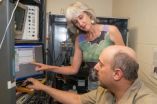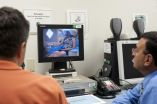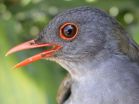(Press-News.org) Leslie Henderson is concerned about steroid abuse, not necessarily by sports luminaries like Barry Bonds and Mark McGwire, but rather by adolescents.
"There is this disconnect among young people that somehow your emotions, your thought processes—things that have to do with your brain—are separate and different from what steroids may be doing to your body—your muscles, your heart, or your liver, or anything like that," says Henderson, a professor of physiology and neurobiology, and of biochemistry at the Geisel School of Medicine at Dartmouth. She is also the senior associate dean for faculty affairs at Geisel.
Henderson reports that websites targeting steroid users often acknowledge that steroids can affect your body—that's why they are taken—or they can make you aggressive. However, they do not say anything about changing the way your brain works. "Teenagers need to recognize that these drugs actually do things to your brain, and your behavior comes from your brain," she says.
The drugs of concern are anabolic-androgenic steroids (AAS), which are synthetic derivatives of testosterone, originally designed to provide enhanced anabolic (tissue-building) potency with negligible androgenic (masculinizing) effects, according to Henderson and her long-time Dartmouth collaborator Ann Clark, a professor in the Department of Psychological and Brain Sciences.
"Although originally developed for clinical use, AAS administration is now predominantly one of abuse, and the medical benefits of low doses of AAS stand in sharp contrast to the potential health risks associated with the excessive doses self-administered by athletes," they write in a 2003 paper.
In addition to the danger implicit in high dosages is the range of uncontrolled variability in the composition of these illicit synthetics. "Because of their chemical modifications they can also directly interact with neurotransmitter receptors in the brain to change the way they function," says Henderson. These changes are reflected in manifestations of anxiety, as seen in Henderson's laboratory experiments.
However, little regard is given to these potential dangers when the primary objective is a competitive edge in athletic pursuits. Compounding these caveats are the implications of abuse at an early age.
Studies have shown there are "critical periods"—periods of time during adolescence when exposure to steroids can impose permanent changes in both brain organization and function, leading to physiological and psychiatric effects that may still be prevalent even in middle age. The age at which you take them also affects their persistence. From studies using rodents as an animal model, other investigators have also found that, "if you take steroids as an adolescent, those effects are much longer lasting in terms of their negative effects on behavior, especially aggression, than if you take them as an adult," Henderson comments.
In her laboratory work, Henderson has looked at three major behavioral systems typically associated with steroid abuse—reproduction, aggression in males, and anxiety in both sexes.
"We did a lot of work looking at the neural control of reproduction and regions of the brain that were affected by chronic steroid abuse, as well as the transfer centers in the brain that were affected acutely by exposure to these steroids," says Henderson. "More recently, we've also looked at the effects of these steroids on anxiety, elucidating a biochemical pathway that is integral to this."
When Henderson says "we" in reference to her research, she means the "royal we." As a senior associate dean in the medical school, her hours at the bench are expectedly limited. "However, our lab is still active. In fact the past couple years we've had probably our best and most high-profile publications," says Henderson. "Right now the lab has a senior postdoc, a graduate student, and my lab manager, and they are doing all the heavy lifting." Donna Porter is the laboratory manager working with Postdoctoral Associate Joseph Oberlander and graduate student Marie Onakomaiya.
As if she were not busy enough, Henderson is committed to active outreach—bringing science to the public. In November, she is scheduled to participate in a local "Science Café." These are interactive events that take place in casual settings such as pubs and coffeehouses, are open to everyone, and feature an engaging conversation with a scientist about a particular topic.
"It is just something that for me as a scientist I think is incredibly important," Henderson asserts. "We take a lot of taxpayer dollars, and if we can't go out and make what we're doing relevant to the people that are supporting us, we shouldn't be doing what we are doing."
INFORMATION:
The scientific side of steroid use and abuse
2012-08-07
ELSE PRESS RELEASES FROM THIS DATE:
Risk of stroke from cardiac catheterizations
2012-08-07
MAYWOOD, Il. -- When a patient undergoes a cardiac catheterization procedure such as a balloon angioplasty, there's a slight risk of a stroke or other neurological complication.
While the risk is extremely small, neurologists nevertheless may expect to see catheterization-induced complications because so many procedures are performed, Loyola neurologists write in the journal MedLink Neurology.
Cardiac catheterizations include diagnostic angiograms, balloon angioplasties and stent placements. More than 1.4 million procedures are successfully performed each year. Cardiac ...
Mothers, children underestimate obesity in China
2012-08-07
Childhood obesity is on the rise in China, and children and parents there tend to underestimate body weight, according to Penn State health policy researchers.
"Because many overweight Chinese children underestimate their weight, they are less likely to do anything to improve their diet or exercise patterns," said Nengliang Yao, graduate student in health policy and administration. "If they don't make changes, they are likely to be obese and have a lot of health problems in the future -- as we often see in the United States already."
Children between the ages of 6 and ...
New study examines injuries to US workers with disabilities
2012-08-07
A new study conducted by researchers at the Center for Injury Research and Policy of The Research Institute at Nationwide Children's Hospital and The Ohio State University compared medically attended noncccupational and occupational injuries among U.S. workers with and without disabilities.
The study, appearing online in the American Journal of Public Health, found that workers with disabilities are significantly more likely to experience both nonoccupational and occupational injuries than those without disabilities. Rates of nonoccupational and occupational injuries ...
Racial differences in diabetes diagnostic thresholds
2012-08-07
BOSTON – Healthcare providers should take into account differences among racial groups when using hemoglobin A1C levels to diagnose and monitor diabetes, new research from Beth Israel Deaconess Medical Center suggests.
In a study published Aug. 7 in the Annals of Internal Medicine, researchers analyzed National Health and Nutrition Survey data from 2005 to 2008 to examine the association between hemoglobin A1C levels in black and white adults and the risk for retinopathy, an eye complication of diabetes that is detectable early in the disease and can ultimately lead to ...
Extreme plasma theories put to the test
2012-08-07
The first controlled studies of extremely hot, dense matter have overthrown the widely accepted 50-year old model used to explain how ions influence each other's behavior in a dense plasma. The results should benefit a wide range of fields, from research aimed at tapping nuclear fusion as an energy source to understanding the inner workings of stars.
The study also demonstrates the unique capabilities of the Linac Coherent Light Source (LCLS) X-ray laser at the U.S. Department of Energy (DOE)'s SLAC National Accelerator Laboratory. While researchers have created extremely ...
Brain signal IDs responders to fast-acting antidepressant
2012-08-07
Scientists have discovered a biological marker that may help to identify which depressed patients will respond to an experimental, rapid-acting antidepressant. The brain signal, detectable by noninvasive imaging, also holds clues to the agent's underlying mechanism, which are vital for drug development, say National Institutes of Health researchers.
The signal is among the latest of several such markers, including factors detectable in blood, genetic markers, and a sleep-specific brain wave, recently uncovered by the NIH team and grantee collaborators. They illuminate ...
Scientists define new limits of microbial life in undersea volcanoes
2012-08-07
By some estimates, a third of Earth's organisms live in our planet's rocks and sediments, yet their lives are almost a complete mystery.
This week, the work of microbiologist James Holden of the University of Massachusetts-Amherst and colleagues shines a light into this dark world.
In the journal Proceedings of the National Academy of Sciences (PNAS), they report the first detailed data on methane-exhaling microbes that live deep in the cracks of hot undersea volcanoes.
"Evidence has built that there's an incredible amount of biomass in the Earth's subsurface, in ...
WSU researcher sees how forests thrive after fires and volcanoes
2012-08-07
PULLMAN, Wash.—Forests hammered by windstorms, avalanches and wildfires may appear blighted, but a Washington State University researcher says such disturbances can be key to maximizing an area's biological diversity.
In fact, says Mark Swanson, land managers can alter their practices to enhance such diversity, creating areas with a wide variety of species, including rare and endangered plants and animals.
"The 1980 eruption of Mt. St. Helens, for example, has created very diverse post-eruption conditions, and has some of the highest plant and animal diversity in the ...
Birds do better in 'agroforests' than on farms
2012-08-07
SALT LAKE CITY, Aug. 7, 2012 – Compared with open farmland, wooded "shade" plantations that produce coffee and chocolate promote greater bird diversity, although a new University of Utah study says forests remain the best habitat for tropical birds.
The findings suggest that as open farmland replaces forests and "agroforests" – where crops are grown under trees – reduced number of bird species and shifts in the populations of various types of birds may hurt "ecosystem services" that birds provide to people, such as eating insect pests, spreading seeds and pollinating ...
Color-coded labels improve healthy food choices in employees from all backgrounds
2012-08-07
A program designed to encourage more healthful food choices through simple color-coded labels and the positioning of items in display cases was equally successful across all categories of employees at a large hospital cafeteria. In an article appearing in American Journal of Preventive Medicine, a team of Massachusetts General Hospital (MGH) researchers report that the interventions worked equally well across all racial and ethnic groups and educational levels.
"These findings are important because obesity is much more common among Americans who are black or Latino ...





